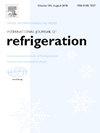Multi-objective optimization of the plate-fin heat exchanger coupled with ortho-para hydrogen conversion for hydrogen liquefaction
IF 3.5
2区 工程技术
Q1 ENGINEERING, MECHANICAL
International Journal of Refrigeration-revue Internationale Du Froid
Pub Date : 2025-02-24
DOI:10.1016/j.ijrefrig.2025.02.020
引用次数: 0
Abstract
Catalyst-filled plate-fin heat exchangers (CFPFHE) are the preferred choice for converting ortho-hydrogen to para-hydrogen in hydrogen liquefaction systems. However, the effects of combining heat exchanger structural variations with changes in catalyst particle parameters on ortho-to-para hydrogen conversion are rarely discussed. This study first conducts the sensitivity analysis on the structural parameters of the heat exchanger and the geometric parameters of the catalyst particles. Then, based on the response surface methodology (RSM), the interaction effects of these parameters on the overall performance of CFPFHEs are explored. The results indicate that the fin spacing and porosity are the key factors affecting the comprehensive performance of CFPFHEs.
The heat transfer enhancement factor TEF is defined to comprehensively assess the thermal performance (j factor) and hydraulic performance (f factor) of the CFPFHE. The ortho-para hydrogen conversion rate η is introduced to evaluate the conversion efficiency of the CFPFHE. Finally, the multi-objective optimization targeting TEF and η is conducted and the optimal parameters for the CFPFHE in the specific commercial hydrogen liquefaction process is obtained. Compared to the initial design scheme, it is found that the TEF of the optimized structure increases by 109.6%, and the η increases by 63.8%. Additionally, the TEF and η calculated through numerical simulation have the errors within 5% compared to the predicted results. Therefore, the multi-objective optimization method for the CFPFHE based on the RSM is relatively reliable. This method can provide guidance for the design and optimization of CFPFHEs in the hydrogen liquefaction process.
正交对氢转化板翅式换热器氢液化多目标优化
在氢液化系统中,填充催化剂的板翅式换热器(CFPFHE)是将正氢转化为对氢的首选。然而,结合换热器结构变化和催化剂颗粒参数变化对正对氢转化的影响却很少被讨论。本研究首先对换热器的结构参数和催化剂颗粒的几何参数进行敏感性分析。然后,基于响应面方法(RSM),探讨了这些参数对CFPFHEs整体性能的交互影响。结果表明,翅片间距和孔隙度是影响CFPFHEs综合性能的关键因素。定义传热强化系数TEF,以综合评价CFPFHE的热性能(j因子)和水力性能(f因子)。引入正交对氢转化率η来评价CFPFHE的转化效率。最后,以TEF和η为目标进行了多目标优化,得到了CFPFHE在特定工业氢气液化过程中的最优参数。与初始设计方案相比,优化后的结构TEF提高了109.6%,η提高了63.8%。通过数值模拟计算得到的TEF和η值与预测值的误差在5%以内。因此,基于RSM的CFPFHE多目标优化方法是比较可靠的。该方法可为CFPFHEs在氢气液化过程中的设计与优化提供指导。
本文章由计算机程序翻译,如有差异,请以英文原文为准。
求助全文
约1分钟内获得全文
求助全文
来源期刊
CiteScore
7.30
自引率
12.80%
发文量
363
审稿时长
3.7 months
期刊介绍:
The International Journal of Refrigeration is published for the International Institute of Refrigeration (IIR) by Elsevier. It is essential reading for all those wishing to keep abreast of research and industrial news in refrigeration, air conditioning and associated fields. This is particularly important in these times of rapid introduction of alternative refrigerants and the emergence of new technology. The journal has published special issues on alternative refrigerants and novel topics in the field of boiling, condensation, heat pumps, food refrigeration, carbon dioxide, ammonia, hydrocarbons, magnetic refrigeration at room temperature, sorptive cooling, phase change materials and slurries, ejector technology, compressors, and solar cooling.
As well as original research papers the International Journal of Refrigeration also includes review articles, papers presented at IIR conferences, short reports and letters describing preliminary results and experimental details, and letters to the Editor on recent areas of discussion and controversy. Other features include forthcoming events, conference reports and book reviews.
Papers are published in either English or French with the IIR news section in both languages.

 求助内容:
求助内容: 应助结果提醒方式:
应助结果提醒方式:


